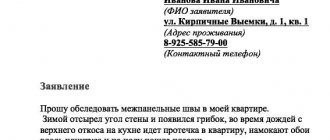Legal regime of marital property
The RF IC determines that property acquired by spouses in a legal marriage with funds from the common family budget is joint property (Article 33). If they wish to establish a different form of ownership, then before or after the wedding they have the right to draw up a marriage contract (Article 42).
If one of the spouses has such a desire, then the division of property in common ownership can be carried out both during the marriage and after its dissolution. A third interested party may also request the procedure.
For example, creditors who need to collect debt from a husband or wife.
Spouses have the right to divide joint property through a settlement agreement. The division may be carried out in kind or in shares (Article 38 of the RF IC).
If we are talking about real estate, then the spouses own it as joint property or draw up an agreement to determine the share. If controversial issues arise in the division of property, the husband or wife have the right to file a claim in court. When dividing common property in 2020, the shares of the spouses will be recognized as equal, unless other conditions are fixed in the marriage contract. When a real division of property is made, each spouse receives real estate according to the previously awarded shares.
When and why is it necessary to determine shares?
Common ownership of residential premises does not always give an idea of what part of the housing belongs to each of the co-owners. Whether they own the apartment equally, or whether one of the owners has the right to a larger share than the other, joint ownership will not give a clear answer to this. Title documents can only indicate the composition of the owners, which in some cases is not enough, then the allocation of shares of each of them will be required.
For example, a mother and two sons inherited a three-room apartment with a total area of 90 square meters from a relative. meters. The will did not indicate the size of the inherited parts of each of the beneficiaries, but it was stipulated: since the heiress at one time helped the testator to pay off the loan for the apartment free of charge, in monetary terms her help amounted to 600 thousand rubles, therefore her part of the inheritance should be increased equivalent to her contribution in the purchase of housing.
The entire apartment was valued at 3 million rubles. Thus, in monetary terms, the shares were:
3,000,000 – 600,000 = 2,400,000/3 = 800,000 for each of the sons and
800,000 + 600,000 = 1,400,000 mother.
The shares were allocated as follows: the mother was assigned 46% of the apartment, and the sons were assigned 27% of the living space. by area the shares were distributed as follows:
the mother received a part of the apartment equal to 41 square meters, the sons were given shares of 24 square meters each.
The most common situations when it is necessary to determine shares:
- Divorce proceedings followed by division of jointly acquired property. Of course, most often spouses own the living space in equal shares, and accordingly, during a divorce, they divide the living space in half, but there are often situations when one of the spouses added personal funds to purchase an apartment, or a marriage contract was drawn up, which stipulates a different division procedure. In these cases, determining the shares is necessary.
- Intention to dispose of one's share contrary to the wishes of the other co-owners. For example, one of the owners moves to another locality and he needs to allocate his share in order to sell it, or receive monetary compensation for his part of the apartment from other co-owners, but since it is not known exactly what area he owns, it is also necessary to determine his shares.
- Opening an inheritance case. Inherited property is not always transferred equally to all applicants; for example, the spouse of the deceased, according to the law, has the right to half of his property, and the other half is inherited by other beneficiaries, often also in different shares.
- Transfer of part of the residential premises to minor children.
Determining shares in the situations listed above, as well as in other, more rare cases, makes it possible to establish the specific part of each property in a common residential area. But there is a limitation here: not a single share, even the smallest one, should be below the minimum permissible size in the region, usually 12-16 square meters per owner.
This procedure can be performed in one of three ways:
- conclusion of a voluntary agreement;
- determination of shares in accordance with the marriage contract;
- filing a claim in court for forced allocation of shares.
Marriage contracts in our country are concluded quite rarely, and of the other two options, the most optimal is the conclusion of a voluntary agreement.
Special cases
The process of allocating a part of real estate can be carried out in different situations:
- in a private house, and the isolation can concern any part of it or can be represented by the construction of a separate entrance;
- in an apartment, but it should be possible to separate one room;
- in common shared ownership, real estate is divided according to the number of owners.
Important! Each case is considered individual, so if the owners cannot agree amicably, then the decision is made by the court.
How to allocate a share in kind in a residential building, legal practice? Watch in this video:
Examples from judicial practice
Allocation of a share in an apartment is considered a simple process if a citizen owns a part of the apartment approximately equal to one room. The number of communal apartments is still considered large enough, so there are no obstacles to allocating part of the property.
After a lawsuit, when a shared common apartment is divided, the status of the property changes, so each owner receives his own separate part.
In judicial practice, situations where an apartment is divided in kind are rare, so this process is usually implemented in relation to residential buildings. There are cases when a division was made in a house belonging to a housing cooperative.
Thus, shares in kind can be allocated when drawing up a special agreement between the owners or after a trial.
Each option has its own characteristics and requires the preparation of a complete package of documents.
This process allows each person to become the full owner of a specific part of the apartment or house, so he can use and dispose of it at his own discretion.
Differences between joint and shared ownership
Citizens sometimes cannot distinguish between the concepts of common joint and common shared property. Even if you read the articles of the Civil Code of the Russian Federation carefully, the meaning of the phrases is identical, but to draw up a legal document it is very important to choose a subtype that is correlated with a specific case.
Subtypes of common property:
- Common property based on the right of joint ownership.
- Common shared ownership.
What's the difference? Everything is very simple. In the first case, the thing initially has the status of a common one without the presence of separate parts. Shared ownership, on the contrary, involves the separation of a certain part from a single object. As an example, consider a shared apartment, which according to the papers is owned by two or more persons. If you look at the document certifying ownership, it will indicate a specific share, for example, ½ belongs to Ivanov, 1/5 belongs to another person, etc. Individuals already have a clear idea in advance of what exactly they can claim when dividing the property.
Ideal and real shares
By law, each spouse has the right to half the apartment, even if the rooms are unequal. In legal practice this is called the “ideal share”. There is also the concept of “real shares”: the parties, by concluding an agreement, secure the right of each to dispose of (and sometimes use) one of the rooms.
Even the court can deviate from the ideal share and determine the share of one of the spouses to be greater than the other. This happens if during the course of married life the husband invested personal funds and made improvements to the property. Or if after a divorce the children remain with their mother.
Shares for an apartment or residential building
The terms of the agreement on the allocation of shares may establish any size thereof. It should be taken into account that after the procedure, each transaction with this real estate will require notarization. Regardless of the size of the allocated share, each owner is an equal participant.
Determination of shares based on maternity capital
Federal Law No. 256 establishes that if real estate was acquired or reconstructed using maternity capital funds, then a share in the apartment must be allocated to each family member. This means that if maternity capital was accrued after the birth of the second child, then both children and each parent should receive equal shares (provided that the spouses are married).
Should maternal capital be shared by the father?
Not really
Since April 2020, the procedure for allocating shares for minor children in property has been simplified. Now, if the apartment was initially registered as joint property, when drawing up an agreement, you do not need to have it certified by a notary. But if the property is in shared ownership, contacting a notary office is necessary.
Determination of shares in a mortgaged apartment
An agreement to determine shares in a mortgage apartment in 2020 cannot be valid until the loan debt is fully repaid. It’s just that the bank that holds the property as collateral will not give permission to carry out the transaction, because this will require changes to a large number of documents.
Determination of shares between spouses and children
If there is a need to determine shares in property between relatives, then, at the request of the parties, the agreement is drawn up in simple written form. When a transaction affects the interests of minor children, it is required to initially obtain the consent of the guardianship authorities. Parents or guardians are required to represent the interests of the child. They also sign the text.
Attachments to the claim
Art. 132 of the Code of Civil Procedure of the Russian Federation determines the list of documents that must be attached to the statement of claim.
- A copy of the claim. The number of copies depends on the number of participants in the process - everyone must receive their own and 1 copy for the judge.
- Applicant's identity card. A civil passport, residence permit, or other document identifying the plaintiff will be suitable.
- Technical passport for the apartment.
- Documents on the basis of which the plaintiff acquired ownership of a share in the apartment.
- Information about payment of the state fee, the amount of which depends on the cost of the claim.
- Other documents related to the case.
Important! In some cases, the plaintiff cannot independently obtain any documents. The law allows you to attach to the claim a petition for the court to request the necessary document from the relevant authority. Consult with a lawyer about how to properly draft your petition.
During the court hearing, the judge may oblige any of the participants in the process to provide certain information and documents.
The nuances of signing a division agreement in kind
If the co-owners of the property wish to receive not a hypothetical, but a specific separate housing, they can formalize the allocation of a share in kind in the common shared property. If in a regular agreement on the division of property the shares between the co-owners are allocated on paper, then in the case of a natural equivalent, each should receive a separate, autonomous housing or part of the land plot.
If it is impossible to divide the property into parts isolated from each other (for example, if a one-room apartment is in collective ownership), the co-owners agree on monetary compensation. Before submitting to the MFC and Rosreestr, documents on the delineation of real estate in kind must be certified by a notary in the presence of all co-owners. IMPORTANT! The property should not be pledged to the bank or be under arrest in the SSP, otherwise the agreement will be declared invalid.
The essence of the problem
If the property is in shared ownership, sooner or later it will have to be divided. This can be done in two ways - in kind (in kind) or in value form. In the first case, the parties receive direct parts of the object (for example, around the room).
But they implement this in two ways:
- Legally, by dividing a dwelling into two or more through redevelopment and registration of the resulting objects for the owners alone.
- Conditionally - accommodation with shared accommodation. Everyone is barricaded in their own room, but common areas have to be shared. Here, a claim to the court for the allocation of a share is not filed.
In the second, there are also two options. Either the shared real estate is sold and the money is divided in accordance with the percentage of ownership, or it goes to one, and he buys out the shares of the other owners.
The second option is much more convenient. The first one is most often chosen in order to incite a conflict with the co-owners.
How to correctly draw up an agreement on the allocation of a share in kind
Citizens who own a property under the right of common ownership have equal rights to use and dispose of this property. Moreover, each of the co-owners has a certain share in the property right.
For example, if a residential property is jointly owned by three citizens, then each of these citizens can own 1/3 of this property. Another distribution of shares is possible: one citizen owns 1/2 of the object, and the shares of the remaining co-owners – 1/4.
An agreement to allocate a share in kind is an agreement reached between all co-owners, as a result of which the share of each of these co-owners changes from a percentage to in kind. The easiest way is to allocate a share in kind from a land plot.
The process of allocating a share from a residential property is much more complicated. As a result of such allocation, each owner must receive a property suitable for living.
Based on the norms enshrined in the current legislation of the Russian Federation, the agreement on the allocation of a share in kind must contain the following information:
- surnames, first names and patronymics of citizens who own a property by right of common ownership, as well as details of identification documents of these citizens and contact information;
- a detailed description of the subject of the transaction being concluded. It is necessary to list the main technical characteristics of the property from which shares in kind are allocated;
- a clear definition of shares, both allocated and remaining in common property;
- information about the documentation establishing the right of citizens to own shares in this real estate property.
Let us note that the agreement on the allocation of a share in kind is drawn up on the basis of full consensus of all participants in the common ownership. The agreement includes a clause stating that it is impossible for one of the participants to terminate this agreement unilaterally.
We especially emphasize that no encumbrances should be imposed on the property from which the share in kind will be allocated. That is, this object should not be pledged or under arrest.
Thus, an agreement on the allocation of a share in kind is a documentary registration of the voluntary expression of will of citizens who own a property on the basis of common ownership rights.
Attention! If it was not possible to reach an agreement on the allocation of a share in kind, the citizen who initiated this process will have to apply to the courts with a claim for the forced allocation of a share in kind.
Separately, we note that based on the norms enshrined in Part 4 of Article 252 of the Civil Code of the Russian Federation, in a situation where a property cannot be divided into natural shares, the owner who initiated the separation process must buy out the shares of the remaining co-owners.
How is compensation paid during the property allocation of a share?
In cases where the value of the property intended for allocation is less than its property share, the initiator of the procedure has the right to monetary compensation equal to the difference between the property share and the actually allocated share.
All conditions for payment of monetary compensation, as well as its amount, are stipulated in the agreement. According to paragraph 4 of Art. 252 of the Civil Code of the Russian Federation, in cases where actual allocation is impossible, the remaining co-owners are obliged to pay the initiator of the division monetary compensation for his part of the property. In this case, the co-owner who decided to allocate his share loses ownership of the property, the remaining co-owners share his part of the property in equal shares or other shares specified in the agreement.
For example, three brothers are co-owners of a two-room apartment in equal shares. The elder brother decided to move to another locality and invited the other two to allocate his share in kind. A technical expert invited by the older brother concluded that the allocation of a share in kind was impossible, that is, the only option for allocating a share was payment to the initiator of the procedure by the other two co-owners of monetary compensation for his part of the property.
The middle brother did not have the financial ability to pay his share of the debt; the younger brother took on the entire payment. The agreement on the allocation of shares stated that the younger brother pays the older brother monetary compensation in full, and the older brother’s share completely becomes the property of the younger brother. Thus, one co-owner retained his 1/3 share of the apartment, the second became the owner of 2/3 of the living space.
Price
Certification of an agreement on the allocation of a share in kind at a notary office is a paid procedure. Payment is made either by the initiator of the allocation, or the amount to be paid is divided between all co-owners; this will depend on how the co-owners of the property decide among themselves.
The amount you will have to pay directly depends on the cadastral value of the allocated part of the property. According to paragraphs. 5 p. 1 art. 333.24 of the Tax Code of the Russian Federation, the payment amount will be 0.5% of the monetary equivalent of the allocated share. There is a lower and upper limit for the payment: it cannot be lower than 300 and higher than 20,000 rubles.
Payment calculation example
Vadim is a co-owner of a large plot of land, which he owns jointly with the other two owners in equal shares. The cost of the storage unit is 15 million rubles. In this case, the allocated share in monetary equivalent will be 5 million rubles. Let's calculate the payment amount:
5,000,000 * 0.5% = 25,000 rubles.
But since the upper limit of payment cannot be higher than 20,000 rubles, when certifying the agreement at the notary’s office, Vadim will have to pay exactly 20 thousand rubles.
Does the agreement need to be registered with a notary?
Until the beginning of 2020, the agreement on the allocation of a share in kind was not subject to mandatory certification by the notary authorities. However, from the moment the federal law of July 13, 2015 No. 218-FZ “On State Registration of Real Estate” came into force, agreements on the allocation of shares in kind are subject to mandatory certification by notaries.
On the one hand, this increases the costs of citizens, but on the other hand, it simplifies the process, since a notary will draw up the agreement.
Rules for filing a claim
Applications for the allocation of a share in property are submitted in the general manner to a court whose competence is to consider disputes such as the allocation of a share.
Jurisdiction
Resolution of cases on the allocation of a share from property in the first instance falls within the competence of the magistrate (for a claim worth less than 50 thousand) or district courts. Which body should you file a claim with should be clarified based on the cost of the claims. Most often, such cases are heard by district courts due to the high cost of real estate.
The application is submitted based on norm 29 of the Code of Civil Procedure of the Russian Federation, to the authority in the territory of residence of the defendant.
Civil procedural legislation establishes several options for filing a claim for the allocation of a house or apartment:
- apply in person - during the reception time you should visit the court address, register the application in the office, then submit it for consideration. One of the copies of the claim will be returned to the applicant with a note of acceptance;
- through the post office - the claim is sent by registered mail. Proof of receipt is a return receipt. All necessary papers and calculations, as well as a list of investments, should be attached to the application.
- using the Internet: 1) send photocopies of documents through the “government services” resource; 2) on the court’s website, collecting all the necessary documents in electronic form (a qualified electronic signature is required).
Terms of consideration
The statement of claim is accepted by the court no later than 5 days. If the application is accepted by the court, the applicant will receive a notice setting a time and date for the trial.
Based on paragraph 1 of Art. 154 of the Code of Civil Procedure of the Russian Federation, within two months after the filing of claims, the judicial authority is obliged to consider the case on the allocation of a part of the property.
In practice, this period may be delayed if an examination is ordered. The course of the procedural 2-month period is suspended for this time, but the total time the claim for the allocation of a share is pending in court will be many times more than 2 months.
Required documents
To formalize the allocation of a share in kind, you will need to provide cadastral documentation for the property being divided.
In addition, to carry out the state registration procedure, you will need to provide the following documentation:
- cadastral passport of the property from which the share is allocated;
- technical plan of this facility;
- documentation confirming citizens' ownership of this property.
In addition, you will need to attach financial documentation confirming that the state fee has been paid.
The final part of the petition
When drawing up a sample statement of claim for the allocation of a share in kind in a residential premises, it is necessary to work out the petition part in detail. Here again the size of the share, the address of the property, the procedure for allocating part of the property and the possibility of paying compensation are reported. If you are going to pay money, indicate the exact amount. Then list the papers attached to the claim:
- Copies of the application itself according to the number of participants in the proceedings.
- Confirmation of payment of state duty.
- Documents confirming rights to a certain part of the property.
- Evidence of rights to common shared property.
- Papers for residential premises and a technical passport from the BTI.
- Other documents relevant to the case.
All papers, except the fee payment receipt, must be copied according to the number of participants in the proceedings. At the end of the claim, a signature and date of appeal are placed.
Free initial consultation with a lawyer Let's look at your legal situation or question. We'll tell you what to do next. Call - it's free:
- For residents of Moscow and Moscow Region:
- Other regions of Russia:
Also write to us via online chat or form on the website.
As an advertisement
Allocation of shares in an apartment
An agreement on the allocation of shares in an apartment is drawn up on general principles that are taken as the basis when concluding such transactions. The document must be submitted to the notary's office for verification. The act is drawn up on a regular sheet of A-4 format. Information that must be indicated in it about the separation of real estate from joint ownership:
- Personal data of each apartment owner.
- Cadastral and technical information about the residential premises (indicate dimensions, legal address, type of construction, etc.).
- The amount of shares due to each party after the conclusion of the agreement. In order for the notary to be able to immediately fill out the deed, it is necessary to determine in advance the exact size of each share and provide a technical document with a detailed floor plan.
- Title papers. A document confirming the ownership of each party to the agreement on the divisible property.
In addition to the main package of documents, the parties must provide certificates of the absence of utility liens.
Agreement on determining shares
A privatized apartment is subject to division between the owners by agreement or through the court. The first option is much simpler and more effective, and also saves time, effort and personal resources of applicants. After the parties reach a compromise, and the citizen receives his share, he will be able to transfer the share in the apartment to a relative, bequeath the property, sell it, deprivatization of the share in the apartment is also permissible, i.e., returning the property to the state, but this procedure involves some complexities and requires competent legal support.
The agreement on the division of real estate is drawn up in the prescribed form. It is better to involve an experienced lawyer in the procedure, who will help you prepare everything correctly and legally, and avoid common mistakes. The standard form contains details that must be filled out, namely, it is important to indicate:
- document's name;
- date and place of its signing;
- contact and passport details of the parties to the transaction;
- location of the property;
- information from cadastral and technical documentation;
- certificate data from the Unified State Register;
- size of shares;
- information about the encumbrance of property.
Read also: Transfer of rights to real estate - when and in what amount is the state registration fee paid?
By agreement of the parties, changes may be made to the document. However, the main rule is the literacy and validity of the contract. The presence of errors and inaccuracies may lead to unpleasant legal consequences in the future. To exclude this, you need to know in advance what this document contains, so you should follow the agreement on our website, study its structure and understand the sequence of entering data. Focusing on the sample, it will be much easier to create your own version of the document.
The agreement must be registered with Rosreestr, otherwise it will not acquire legal force, the old data will remain in the main state register, and the transaction may be considered illegal. The law gives applicants no more than two weeks to submit papers and re-register property. The same amount of time will be spent reviewing the papers and issuing a certificate of ownership.
Allocation of shares in maternity capital
Maternity capital is one-time financial support for families who have had a second and subsequent child. Initially, the allocation of funds was aimed at improving the demographic situation and creating favorable conditions for the development of the child himself.
In many ways, it is the intended purpose that is associated with the obligations of the parents to enter into an agreement on the allocation of part of the property to the children. In other words, when including capital funds in the mortgage lending program, it is necessary to prepare an obligation with a notary, according to which the parents will assign a certain part of the future apartment or house to the property of their children.
There are two ways to transfer a share to children:
1. By concluding a preliminary agreement. You can draw up the document yourself or go to a notary who has ready-made forms to fill out.
On a note! Drawing up a deed with the involvement of a notary costs approximately 1,000-3,000 rubles - it all depends on the specifics of the property being divided.
2. By concluding a gift agreement. A gift agreement is considered a more economical method, since the document does not require notarization.
If the owner of maternity capital chooses to conclude an agreement, he will have to contact a notary, collecting the following papers:
- A document indicating that the spouses are married.
- Passports of both spouses, as well as the birth certificate of each child.
- MK certificate.
- A document for an apartment or house, from which shares will be allocated for each family member.
- A copy of the notarial undertaking. The obligation documents the determination of the spouses to re-register the real estate acquired with funds from capital into the status of common shared ownership.
- Extract from the Unified State Register.
Having in hand a certified sample of a notarial agreement on the distribution of part of the real estate acquired with the inclusion of funds from capital, the family must contact the nearest branch of the MFC to give the document legal force.
The minimum share of an apartment or house that a child can claim is 6 m².
The division of common shared property, as well as other procedures related to the ownership and disposal of joint property, is carried out on the principle of equality of the parties. If a preliminary agreement has not been reached between the participants, all shares are recognized as equal, but with the retention of the right of pre-emption in the event of sale to other persons.
In what cases can an agreement be drawn up?
It must be emphasized that the main requirement imposed by the current legislation of the Russian Federation on an agreement on the allocation of a share in kind is complete voluntariness. In addition, if we are talking about allocating a share in kind from a residential property, several premises suitable for living should be formed, separated from each other.
If a share in kind is allocated from a land plot, then each plot of land formed as a result of the division must have a separate driveway.
It is quite simple to allocate a share in kind from a land plot. But if we are talking about allocating a share from a residential property, the situation becomes much more complicated. Quite often, in order to allocate a share from a residential property, redevelopment is required. Redevelopment, in turn, requires obtaining various approvals.
Important! The law provides for the possibility of allocating a share to only one of the co-owners of the property. In such a situation, the remaining citizens will continue to own this object on the right of common ownership.
If it is not possible to allocate a share in kind, then the citizen who initiated the allocation process can buy out the shares from the remaining co-owners. At the same time, the value of the shares of these citizens is determined by independent appraisal companies or on the basis of an agreement with the citizen who wants to buy out these shares.
If at least one of the co-owners objects to the allocation of a share in kind from a residential property, it will not be possible to conclude an agreement. In such a situation, you will need to go to court with a claim for the forced allocation of a share in kind.
Pre-trial settlement
First of all, you need to check the title documentation. Often it already indicates which owner and what share of the property belongs (in percentage or m2). To determine the size of your part, it is enough to divide the entire area of the property (for example, an apartment, plot or non-residential premises) by the number of shares of each participant.
Before going to court and before filing a claim for the allocation of a share, it is advisable for the owners to try to resolve the issue of allocation on their own. Since in the future the papers on the attempt at a peaceful settlement will be evidence in court proceedings, it is better to send the proposal through the post office using a registered letter, accompanied by a return receipt.
Also, before filing a claim for the allocation of a share in kind through the court, a technical examination should be carried out. This procedure will reveal:
- The possibility of separating a share from the property.
- Determination of the real as well as market price of the property.
- The degree of deterioration of the property.
- The need for redevelopment for allocation and its cost.
- The amount of material compensation if it is impossible to allocate ideal shares.
It is the conclusion of the technical examination that will be one of the main pieces of evidence confirming the possibility of allocating a share in kind.
Sample agreement on the allocation of a share in kind in common shared ownership
The legislation does not provide for any unified forms of agreement on the allocation of part of a real estate property in kind. But the minimum requirements for drawing up the document will still have to be met. The document must contain the following information:
- personal data of all signatories (full name, registration addresses and passport details);
- date and place of conclusion of the agreement;
- a brief description of the object from which the share is allocated: house, apartment, land plot, address of the property, technical and cadastral information, additional number of floors for buildings, availability of communications;
- on the basis of what documents the right of shared ownership of real estate arose;
- the size of the shares of all co-owners;
- the size of parts of the property retained by the co-owners after allocation;
- in the case of payment of monetary compensation for the allocated share - the amount of this compensation and the method of payment;
- information about the notary responsible for registering the agreement;
- the rights and obligations of all signatories;
- a record that the property has no encumbrances in the form of arrest and is not pledged;
- a record that the signatories have no material claims against each other;
- other information.
If you are a co-owner of any property and decide to separate your part of the property into a separate property, do not try to do this yourself, without the involvement of an experienced lawyer. Of course, at first glance, this procedure seems simple and understandable, but each individual case has many “pitfalls” that are invisible to an inexperienced person in jurisprudence.
It’s quite easy to make a mistake: an incorrectly indicated share size, a legal error in the writing of any clause of the contract, documents not collected in full or not those that are required - all this, at best, can slow down the procedure, at worst, make it impossible .
How to draw up a sample agreement on determining shares in an apartment in common ownership
- In case of privatization , inheritance , purchase , divorce , in the absence of any additional factors (will, documented expenses for the purchase of most of the real estate), the real estate is divided into all owners in equal shares ;
- When entering into an inheritance and there is a will , the size of the shares will be determined by the will;
- procedure for operating property registered as shared ownership;
- unilateral ban on refusal to fulfill all obligations;
- absence of any encumbrances on real estate ;
- absence of any material claims against other owners;
- the procedure for making emerging additions and changes to the agreement;
- temporary deadlines for registration of additions and changes.







